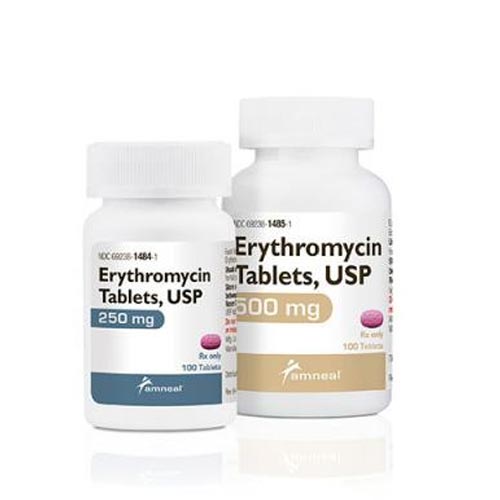Description
Erythromycin is an antibiotic drug produced by a strain of Saccharopolyspora erythraea (formerly Streptomyces erythraeus) and belongs to the macrolide group of antibiotics. It was originally discovered in 1952. Erythromycin is widely used for treating a variety of infections, including those caused by gram-positive bacteria, gram-negative bacteria and many other organisms.
Erythromycin is indicated in the treatment of infections:
Upper respiratory tract – Streptococcus pyogenes, Streptococcus pneumoniae, or Haemophilus influenzae, Lower-respiratory tract – Streptococcus pneumoniae or Streptococcus pyogenes, Listeriosis caused by Listeria monocytogenes, Pertussis (whooping cough) caused by Bordetella pertussis, Mycoplasma pneumoniae, Legionella pneumophila, Corynebacterium diphtheriae (Diphtheria), Skin and skin structure infections of mild to moderate severity caused by Streptococcus pyogenes or Staphylococcus aureus, infections due to Corynebacterium minutissimum (Erythrasma), Intestinal amebiasis caused by Entamoeba histolytica (oral erythromycins only). Extraenteric amebiasis requires treatment with other agents, Acute pelvic inflammatory disease caused by Neisseria gonorrhoeae, Syphilis caused by Treponema pallidum, Chlamydia trachomatis, Nongonnoconnal urethritis.
Pharmacodynamics
Macrolides, such as erythromycin, stop bacterial growth by inhibiting protein synthesis and translation, treating bacterial infections. Erythromycin does not exert effects on nucleic acid synthesis.
This drug has been shown to be active against most strains of the following microorganisms, treating both in vitro and in clinical infections. It is important to perform bacterial susceptibility testing before administering this antibiotic, as resistance is an issue that may affect treatment.
Gram-positive Organisms: Corynebacterium diphtheriae, Corynebacterium minutissimum, Listeria monocytogenes, Staphylococcus aureus (resistant organisms may emerge during treatment), Streptococcus pneumoniae, Streptococcus pyogenes.
Gram-negative Organisms: Bordetella pertussis, Legionella pneumophila, Neisseria gonorrhoeae.
Other Microorganisms: Chlamydia trachomatis, Entamoeba histolytica, Mycoplasma pneumoniae, Treponema pallidum, Ureaplasma urealyticum.
Mechanism of action
In order to replicate, bacteria require a specific process of protein synthesis, enabled by ribosomal proteins. Erythromycin acts by inhibition of protein synthesis by binding to the 23S ribosomal RNA molecule in the 50S subunit of ribosomes in susceptible bacterial organisms.
It stops bacterial protein synthesis by inhibiting the transpeptidation/translocation step of protein synthesis and by inhibiting the assembly of the 50S ribosomal subunit. This results in the control of various bacterial infections. The strong affinity of macrolides, including erythromycin, for bacterial ribosomes, supports their broad‐spectrum antibacterial activities.
Many strains of Haemophilus influenzae are resistant to erythromycin alone but are found to be susceptible to erythromycin and sulfonamides used in combination. It is important to note that staphylocci resistant to erythromycin may emerge during a course of erythromycin and/or sulfonamides.
Side effects
All medicines may cause side effects, but many people have no, or minor, side effects.Some medical conditions may interact with Erythromycin.
Tell your doctor or pharmacist if you have any medical conditions.
Common erythromycin side effects may include: mild diarrhea or nausea, vomiting, stomach pain, loss of appetite.
Symptoms of overdose may include diarrhea, nausea, stomach cramps, and vomiting. In case of overdosage, erythromycin should immediately be discontinued. Prompt elimination of unabsorbed erythromycin should be attempted, and all other appropriate supportive measures should be initiated. Erythromycin is not removed by peritoneal dialysis or hemodialysis.
This is not a complete list of all side effects that may occur. If you have questions about side effects, contact your health care provider.



zoritoler imol –
As soon as I discovered this site I went on reddit to share some of the love with them.